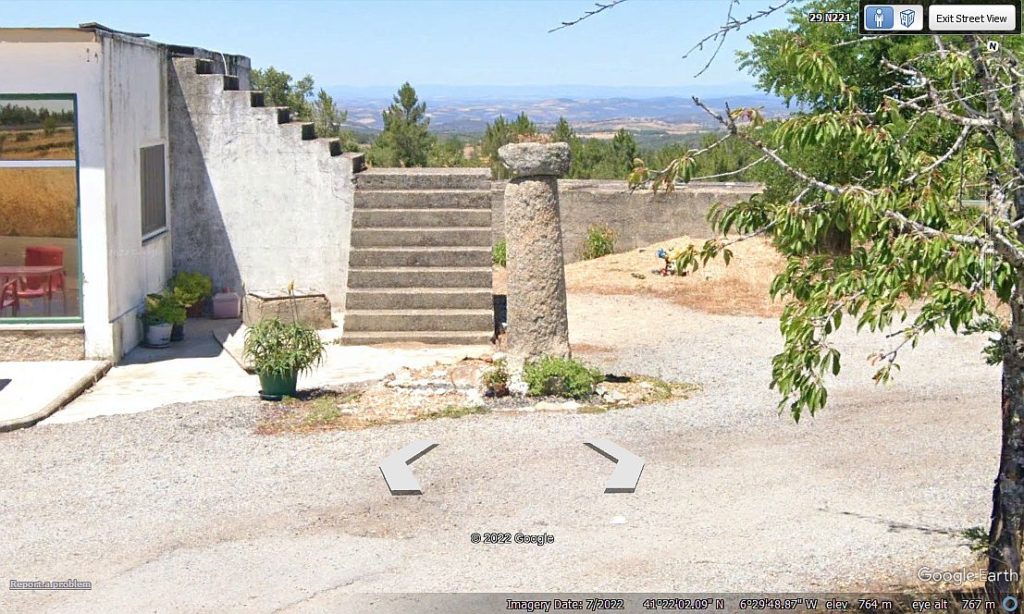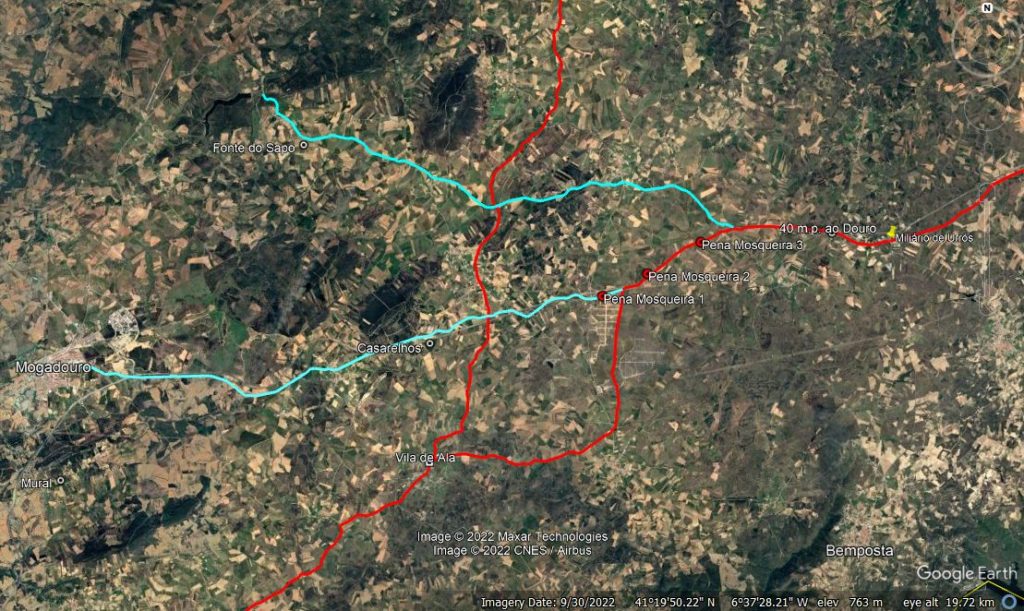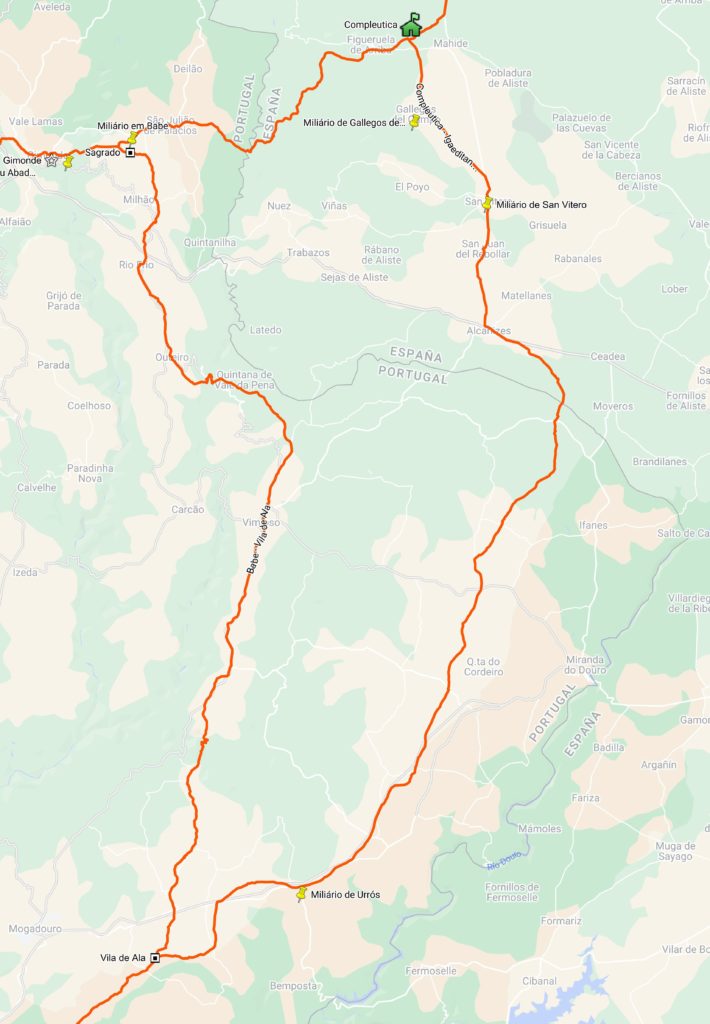There has been a growing interest in a historical path commonly called the Carril Mourisco which runs along the Mirandês plateau. It is an ancient route travelled by the mule drivers until the beginning of the 20th century and was recorded in 1915 by Father Francisco Manuel Alves (better known as Abbot of Baçal) based on notes by Major Celestino Beça, suggesting the possibility of the road going back to the Roman period (Alves, 1915). Consequently, the road was marked as “Antiga Via Romana” on the respective military map, curiously the only time this happens in the entire M888 series. Sande Lemos would publish the route (LEMOS 1993, p. 299) and more recently the respective topographic survey was carried out (LIMA et al., 2015). However, some doubts remained about its route after passing through Brunhosinho, doubts that we finally managed to clear up, and that have clarified the road network in the region.
The Carril Mourisco was part of a large itinerary that started in Compleutica (station of the road Chaves-Astorga located in Figueruela de Arriba) that followed towards the Douro River by San Vitero, entering the current Portuguese territory by Cruz de Canda in Cicouro. From here its route is described by the Abbot of Baçal crossing the plateau Mirandês in the current municipalities of Miranda do Douro and Mogadouro. The doubts raised by various later authors on the chronology of the road has somewhat obscured its importance in the Roman road network, doubts that have since been dispelled by the recent identification of a milestone on the route of the “Carril Mourisco” which is currently at the halt of Urrós, near Café Ramiro, but which would have come from a corral in the parish of Brunhosinho.

Although the cylinder is anepigraphic, we have no doubt that it is indeed a Roman milestone, given its quadrangular base and dimensions, (re)confirming the passage of the track along the railway line towards the Brunhosinho junction, a very important place, as from here the connection branches to Penas Roias and Mogadouro departed, while the Carril branched its course southwards towards Barca Dalva. This road junction is marked by several tumuli over the designation of megalithic set of Pena Mosqueira, showing the road character of these monuments, bringing back the origins of this route to the Late Neolithic (!).
According to our proposal, the milestone of Carril in the Urrós pass corresponds to mile 45, counted from Compleutica. However, as the milestone came from the vicinity of Brunhosinho, it is more likely that its original point of implantation was in the next mile which corresponds to the place where the track crosses the IC5 (41°22’7.42″N, 6°30’40.42″O). The distance from this place to the Douro is about 40 miles, so this could be the value indicated by the marker (as it is a usual value between stages of a journey), thus giving valuable information to travellers. From the following mile (39), the mentioned branch line departed towards Penas Roias, reaching the eighth mile next to the Roman site of Fonte do Sapo (next to the cemetery), which should correspond to a mutatio type road establishment. Returning to Carril, the next mile was reached next to the Pena Mosqueira mound 3, and the following mile was reached next to mound 2, considered the largest and most important of the four monuments of the Pena Mosqueira group. This place is very relevant because here was the point where the Mourisco Railway inflected its direction southwards towards Barca Dalva, and also because from here another branch line that linked it to Mogadouro, also located eight miles away.

From Pena Mosqueira, the Carril followed northwest to the village of Tó, passing through the toponyms “Pinhal de Brunhozinho”, “Lagoa de Thó” and “Pontão de Thó”, as indicated by Celestino Beça (Alves, 1915, p. 7) and not Variz as previously proposed (LIMA et al., 2015, p. 58). At the northern entrance to this settlement there is a cross that marks the location of the milestone, i.e. 32 miles to the Douro. Note that it is eight miles from here to the milestone, suggesting that mutatio would exist here, a hypothesis greatly reinforced by the fact that this is the point where the ‘Carril’ converged on another important itinerary, also originating on the Chaves-Astorga route, but that left from the Babe road station (from the mutatio of the Sacred), following through Vimioso and the old Algoso bridge to Vila de Ala, also covering about 46 miles, curiously (or maybe not), the same value verified for the milestone from Brunhosinho to Compleutica. The route of this last track was finally identified in all its course that is now described here, being also included in the new version of the Routes Map (see 5.0).

Links to the Itineraries:
– Route from Compleutica to Barca Dalva (Carril Mourisco)
– Route from Babe to Vila de Ala
Bibliograophy:
ALVES, Pe. Francisco Manuel (1915) – “Estudos arqueológicos do Major Celestino Beça – A estrada militar romana de Braga a Astorga por Bragança”. OAP Vol. XX, 74-106.
LEMOS, F. Sande (1993) – “Povoamento Romano de Trás-os-Montes Oriental”. Braga: University of Minho. Tese de Doutoramento.
LIMA, A.C. et all. (2015) – “O Carril Mourisco. O traçado romano de uma grande rota contemporânea”. In Côavisão, 17, 54-79.